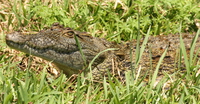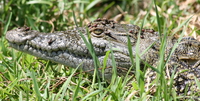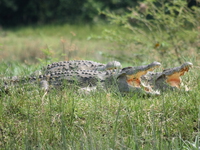crocodiles of uganda
The Nile crocodile's size, widespread range, and overlap with humanity have continued to make them unpopular with humans.
Like all crocodiles, they are quadrupeds with four short, splayed legs; long, powerful tails; a scaly hide with rows of ossified scutes running down their back and tail; and powerful jaws. They have nictitating membranes to protect their eyes and, despite the myths, they do have lachrymal glands, and can cleanse their eyes with tears.
Nostrils, eyes, and ears are situated on the tops of their head, so the rest of the body can remain concealed underwater. Their coloration also helps them hide: Juveniles are grey, dark olive, or brown; with darker cross-bands on their tail and body. As they mature they become darker and the cross-bands fade, especially those on the body. The underbelly is yellowish, and makes high-quality leather.
They normally crawl along on their bellies, but they can also "high walk" with their trunks raised above the ground. Smaller specimens can gallop, and even larger crocodiles are capable of surprising bursts of speeds, briefly reaching up to 12 to 14 km/h (7.5 to 8.5 mi/h). They can swim much faster by moving their body and tail in a sinouous fashion, and they can sustain this form of movement much longer at about 30 to 35 km/h.
The Nile Crocodile (Crocodylus niloticus) is one of the 4 species of crocodiles found in Africa, and the second largest species of crocodile. Nile crocodiles can be found throughout most of Africa south of the Sahara, and on the island of Madagascar. The Nile crocodile can, and sometimes will, easily snatch and devour a human. While it is no longer threatened with extinction as a species, the population in many countries is in danger of vanishing.
The Nile crocodile is the largest African crocodilian and the second largest crocodilian after the Saltwater crocodile, reaching lengths of up to 5 m (16 ft), or rarely up to 6.1 m (20 ft). Good sized males weigh 500 kg (1100 lb), and truly exceptional specimens may exceed 900 kg (2,000 lb).[2] Like all crocodiles they are sexually dimorphic, with the males up to 30% larger than the females, though the difference is even less in some species, like the Saltwater crocodile.
Adult Nile Crocodiles are known to eat zebras, buffalo, warthogs, hyenas, baboons, antelope like the Wildebeest, giraffe, and other crocodiles.
Nile crocodiles only concern is big cats, hippos, elephants and humans. Big Cats have been known to kill and eat nile crocodiles. Adult Nile crocodiles use their bodies and tail to herd groups of fish toward a bank, and eat them with quick sideways jerks of their heads. They also cooperate, blocking migrating fish by forming a semicircle across the river. The most dominant crocodile eats first.
Nile crocodiles only concern is big cats, hippos, elephants and humans. Big Cats have been known to kill and eat nile crocodiles. Adult Nile crocodiles use their bodies and tail to herd groups of fish toward a bank, and eat them with quick sideways jerks of their heads. They also cooperate, blocking migrating fish by forming a semicircle across the river. The most dominant crocodile eats first.
Their ability to lie concealed with most of their body underwater, combined with their speed over short distances, makes them effective opportunistic hunters of larger prey. They grab such prey in their powerful jaws, drag it into the water, and hold it underneath until it drowns. They will also scavenge kills, although they avoid rotting meat. Groups of Nile crocodiles may travel hundreds of meters (yards) from a waterway to feast on a carcass.
Once their prey is dead, they rip off and swallow chunks of flesh. When groups of Nile crocodiles are sharing a kill, they use each other for leverage, biting down hard and then twisting their body to tear off large pieces of meat. This is called the death roll. They may also get the necessary leverage by lodging their prey under branches or stones, before rolling and ripping.









